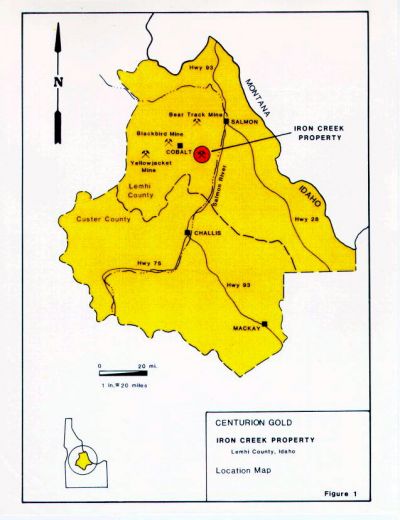Iron Creek Cobalt Project
The Iron Creek Cobalt-Copper Project:
The Iron Creek Cobalt-Copper property in Idaho, consists of seven patented mining claims of approximately 118 acres located in Lemhi County about 26 miles southwest of the town of Salmon, Idaho. Discovered in the 1940's as a possible iron deposit, past work by previous operators identified several zones of cobalt-copper mineralisation. Extensive drilling, sampling, and geologic work was completed on two of the most promising areas. Numerous other exploration targets have been identified on the property that have yet to be fully evaluated.
The first mineral resource of interest referenced in the historical literature is an underground target described by Noranda Exploration in a 1980 report as "two distinct lenses of cobalt mineralization". The first lens was called a "reserve" and was estimated to contain 1,050,000 tons grading 0.61% cobalt (Co) and 0.3% copper (Cu) and having a strike length of about 750 feet. A second lens of high-grade cobalt mineralization occurs to the northwest, and again is described as a "reserve". This lens extends for 600 feet of strike length, is deeper than the first lens, and averages about 0.48% Co and 0.24% Cu. The authors estimated this resource to be around 229,000 tons. In all, the Noranda authors state that between both lenses, they expect the potential for at least two million tons of similar grade resources could be developed. While this area will require more work to bring these resources into today's reserve compliant categories, if confirmed these zones would represent over 15 million pounds of cobalt and over 7.4 million pounds of copper. (As reported in an internal report titled "Iron Creek Prospect, Lemhi County, Idaho (#0483) Progress Report" by Terry A. Webster & Thomas K. Stump for Noranda Exploration, Inc. July 1980).
The reader is cautioned that data included in the reporting of resources pre-dates National Instrument 43-101 or is otherwise not compliant with National Instrument 43-101. The potential quantity and grade is conceptual in nature, that there has been insufficient exploration to define a mineral resource and that it is uncertain if further exploration will result in the target being delineated as a mineral resource. The report does not detail cut-off grades and metal prices used to calculate the historical mineralisation. Such data is marked as being non-compliant, and a qualified person has not verified such data. As a result, the reader is cautioned not to rely upon that data. The Company is not treating the historical estimates as current mineral resources.
- Locations: Iron Creek Cobalt Project
- Status: Exploration
- Mineral Assets: Cobalt-Copper
- Highlights: The Iron Creek project provides Global Cobalt with a foothold in the Idaho Cobalt Belt, the most prolific belt of cobalt mineralisation in the United States.
- Objectives: Bring the historic resources to NI 43-101 standard
- The Iron Creek Cobalt-Copper property in Idaho, consists of seven patented mining claims of approximately 118 acres located in Lemhi County about 26 miles southwest of the town of Salmon, Idaho.
- Discovered in the 19400â?s as a possible iron deposit, past work by previous operators identified several zones of cobalt-copper mineralisation.
- Extensive drilling, sampling, and geologic work was completed on two of the most promising areas.
- Numerous other exploration targets have been identified on the property that have yet to be fully evaluated.
- The Iron Creek project provides Global Cobalt with a foothold in the Idaho Cobalt Belt, the most prolific belt of cobalt mineralisation in the United States.
- Approximately 30,000 feet of diamond drilling and 1,500 feet of underground drifting has been completed exploring the project by previous operators.
- Historic literature defines "two distinct lenses of cobalt mineralization."
- The first lens estimated to contain 1,050,000 tons grading 0.61% cobalt and 0.3% copper and having a strike length of about 750 feet.
- A second lens of high-grade cobalt mineralization of 229,000 tons extends for 600 feet of strike length, is deeper than the first lens, and averages about 0.48% Co and 0.24% Cu.
- Historic met work indicates that the project has low arsenic levels that distinguishes the project from others in the belt
- A positive as it make potential process handling easier and less costly
As a result of past work and development history, Global Cobalt has an extensive database from which to work that will allow us to quickly advance our exploration efforts.
The plan would be to bring the historic resources to 43-101 standard and that would entail the following:
- Compilation of historic data
- Geological analysis with supervision to enhance the understanding of the geology and possible mineralisation
- Geophysical survey: Airborne & Ground
- Diamond drilling: Initial recommendation of +/-7000m to replicate historical drilling work effort


